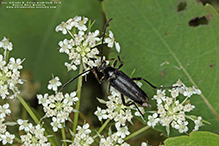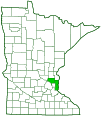Silver flower longhorn beetle
(Grammoptera subargentata)
Conservation • Description • Habitat • Ecology • Distribution • Taxonomy
Conservation Status |
|||
| IUCN Red List | not listed |
||
| NatureServe | NNR - Unranked |
||
| Minnesota | not listed |
||
Description
Silver flower longhorn beetle is small to moderate sized, flower longhorn beetle. It occurs across North America from southern Quebec to Alaska south to North Carolina and California. It is most common west of the Great Plains. Based on the number of reported observations, it is uncommon in Minnesota. However, Cedar Creek Ecosystem Science Reserve (CCESR) in Anoka County reports it as common. It is found in spring and summer on flowers in deciduous and mixed woodlands. Larva feed on dead hardwoods, including sumac, poplar, and, oak. Adults feed on flower pollen from a wide variety of flowers including at least thirteen genera.
Adults are 3 ⁄16″to 5 ⁄16″ (5 to 8 mm) long. The body is robust, broad-shouldered, cylindrical, and almost parallel. Females are slightly larger than males.
The head is black, short in front, inflated behind the eyes, and abruptly constricted in back forming a neck that is visible when viewed from above. The upper part (vertex) is very densely covered with very fine pits. The face slants forward or is nearly vertical. The compound eyes are small, black, and slightly notched. The antennae have eleven segments. They are slender, black, and long, almost as long as the body. The base of each antenna is narrowly separated from the base of the jaw (mandible), and is not surrounded by the compound eye. The second antennal segment is short. All of the segments are cylindrical and are longer than wide. The finger-like sensory organ (maxillary palp) attached to the mouth is blunt at the tip, not pointed.
The upper thoracic shield (pronotum) is black, bell-shaped, and wider than long. It is narrow at the front and almost as wide at the base as the base of the hardened wing covers (elytra). It is moderately inflated on top (dorsally). It has a very shallow impression in the middle near the base. The angles at the rear corners of the pronotum are very sharp and point outward. The surface of the pronotum is very densely covered with very fine pits, and is also covered with short, curved, silvery hairs. This is the feature that gives the beetle its common name. On some individuals the hairs are dark but they are never golden.
The elytra are entirely black, shiny, and elongated, usually less than 2½ times as long as the base is wide. They are broadest at the base and almost parallel from below the base to the rounded tip. The elytral surface is pitted, finely on the basal half, even finer on the rear (apical) half. It is also moderately covered with short dark hairs. The abdomen has five visible segments on the underside. On the female the last segment is rounded at the end and does not have a bump (tubercle).
The legs are long, slender, entirely black, and covered with short hairs and fine pits. The fourth segment (tibia) of each leg has two short spurs at the tip. The last part (tarsus), corresponding to the foot, is black. The tarsus has five segments but the fourth segment is minute and is concealed within the lobes of the heart-shaped third segment, making it appear that there are only four segments. On the hind leg, the tarsi are slender. The third segment is split beyond the middle.
The bases of the antennae, the plate on the face above the upper lip (clypeus), and the legs are sometimes partly reddish.
Size
3⁄16″ to 5⁄16″ (5.0 to 8.0 mm)
Similar Species
Habitat
Deciduous and mixed woodlands
Ecology
Season
April to August
May and June (CCESR)
Behavior
Life Cycle
Larva Food/Hosts
Dead hardwoods
Adult Food
Pollen from a wide variety of flowers including at least thirteen genera.
Distribution |
||
|
Sources |
|
| 10/6/2025 | ||
Occurrence |
||
Uncommon in Minnesota |
||
Taxonomy
Order
Coleoptera (Beetles)
Suborder
Polyphaga (Water, Rove, Scarab, Long-horned, Leaf, and Snout Beetles)
Infraorder
Cucujiformia
Superfamily
Chrysomeloidea (leaf beetles and allies)
Family
Cerambycidae (longhorn beetles)
Subfamily
Lepturinae (flower longhorn beetles)
Tribe
Lepturini
Genus
Superfamily
The idea of moving the families Cerambycidae and related families Disteniidae, Oxypeltidae, and Vesperidae from Chrysomeloidea to create a separate superfamily “Cerambycoidea” is not new, It has not been widely adopted in the scientific community due the lack of evidence that the resulting groups would be monophyletic, meaning that they would contain all of the descendants of the most recent ancestor or ancestral population and no non-descendants. Recent molecular studies have provided new support for the move. Among online taxonomic databases, iNaturalist.org, which is often among the first to adopt taxonomic advances based of recent research, is the only database to adopt the superfamily Cerambycoidea—so far.
Subordinate Taxa
Synonyms
Grammoptera filicornis
Grammoptera quebecensis
Grammoptera rufibasis
Leptura quebecensis
Leptura rufibasis
Leptura similis
Leptura subargentata
Leptura subargentata var. similis
Parallelina filicornis
Parallelina similis
Parallelina subargentata
Parallelina subargentata var. ruficollis
Strangalia similis
Strangalia subargentata
Common Names
silver flower longhorn beetle
Glossary
Clypeus
On insects, a hardened plate on the face above the upper lip (labrum).
Elytra
The hardened or leathery forewings of beetles used to protect the fragile hindwings, which are used for flying. Singular: elytron.
Maxillae
Paired mouth structures of arthropods located immediately behind the mandible and used for tasting and manipulating food. “Under-jaws”.
Palp
Short for pedipalp. A segmented, finger-like process of an arthropod; one is attached to each maxilla and two are attached to the labium. They function as sense organs in spiders and insects, and as weapons in scorpions. Plural: palpi or palps.
Pronotum
The exoskeletal plate on the upper side of the first segment of the thorax of an insect.
Tarsus
On insects, the last two to five subdivisions of the leg, attached to the tibia; the foot. On spiders, the last segment of the leg. Plural: tarsi.
Tibia
The fourth segment of an insect leg, after the femur and before the tarsus (foot). The fifth segment of a spider leg or palp. Plural: tibiae.
Tubercle
On plants and animals: a small, rounded, raised projection on the surface. On insects and spiders: a low, small, usually rounded, knob-like projection. On slugs: raised areas of skin between grooves covering the body.
Vertex
The upper surface of an insect’s head.
Visitor Photos
Share your photo of this insect.
This button not working for you?
Simply email us at info@MinnesotaSeasons.com.
Attach one or more photos and, if you like, a caption.
Alfredo Colon |
 |
MinnesotaSeasons.com Photos
|

Slideshows

Visitor Videos
Share your video of this insect.
This button not working for you?
Simply email us at info@MinnesotaSeasons.com.
Attach a video, a YouTube link, or a cloud storage link.
Other Videos



